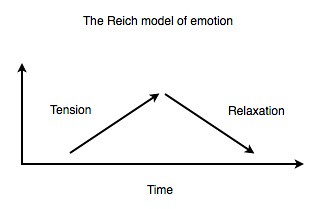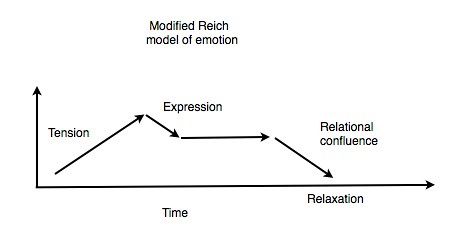(This is an edited version of the previous posting)
When one has a feeling the process usually articulated is the mechanism of tension followed by expression and then relaxation. This originally came from the work of Wilhelm Reich who plays a major role in this aspect of human functioning. He presented the powerful yet simple model of a feeling involving firstly tension followed by expression and then relaxation.
This upon reflection this is too one dimensional. On occasion feelings occur in the context of a relationship or at least whilst in relational contact. One may have a feeling reaction to another person directly or one may express a feeling about something else but in the company of another.
One could argue the response the other party plays is crucial to how successful the emotion is dealt with. Hence we arrive at the vulnerability anxiety equation.
Consider the situation where person A discusses an emotion not related to person B. For example person A is angry at her boss and is telling her husband (person B). The responses by the husband are going to influence how person A deals with or resolves the angry feelings. For example sometimes husbands can get into ‘fixing’ mode and respond to the wife in ways where he is trying to help her to fix the problem with the boss. Often this is not what is wanted and she really just wants him to listen to her as she vents her thoughts and feelings about the matter. He does not understand this and as a result it leaves her with a sense of incompletion with her anger because there is a communication problem with her husband.
As one can see this adds an extra dimension to the original Reichian proposal of how one needs to ‘work through’ emotions. That is, resolving feelings (at least some of the time) is a two person psychological process. In this sense it is deemed erroneous to view the resolution of feelings as a function of one person alone. Instead the feeling, in some instances, must be brought into the relational with another person.
If the other person responds in an effective way then the sense of resolution will be more complete in the emotion laden individual. If the husband had responded by just listening to the wife, then her sense of completion would be more satisfactory and psychologically healthy.
She takes a risk. If she does not raise the angry situation with him then he cannot respond poorly such that she is worse off after her exchange. At the same time if she does not raise it with him then she cannot get that greater sense of completion if he responds in an appropriate way.
It seems reasonable to suggest that dealing with and resolving emotions needs to be seen as more than just one person having some kind of cathartic release. Instead emotions play a central part of relationships and hence one needs to view them in the wider context of relationships which can assist or hinder the process of working through the emotion.
The above example can be shown diagrammatically. In transaction 1 the wife expresses to her husband the angst she felt at work regarding her boss. Two possible responses of his are indicated. First he could cross the transaction and respond from Adult as shown in transaction 2 - “This could be a solution to the problem.” If she is simply wanting to be heard and listened to by her husband then this response will result in a sense of non completion about her feelings.
If he responds from NP in transaction 3 and listens sympathetically then she will experience much more of a sense of completion about the feelings. Thus we are in a position to alter the original Reichian conception of the process of feeling. This diagram comes from Reich (1971).
Moving beyond the purely hydraulic theory of tension build up followed by tension release and adding in a relational component one gets a modified process.
After tension build up (the person feeling the feeling) the expression allows for a release of tension which provides a partial solution. However as is the often the case with feelings, particularly troublesome feelings, the individual also has a desire to talk about it and relate aspects of the event to a close other. If this happens and the other responds in an effective manner then a sense of relational confluence can be seen to be achieved and the feeling is then fully worked through. Without the achievement of relational confluence the feeling could be seen to be unresolved in the psychological sense of the term.
Reference
Reich, W.
1971. The Function of the Orgasm: The Discovery of the Orgone. Meridian: New York
Graffiti





No comments:
Post a Comment